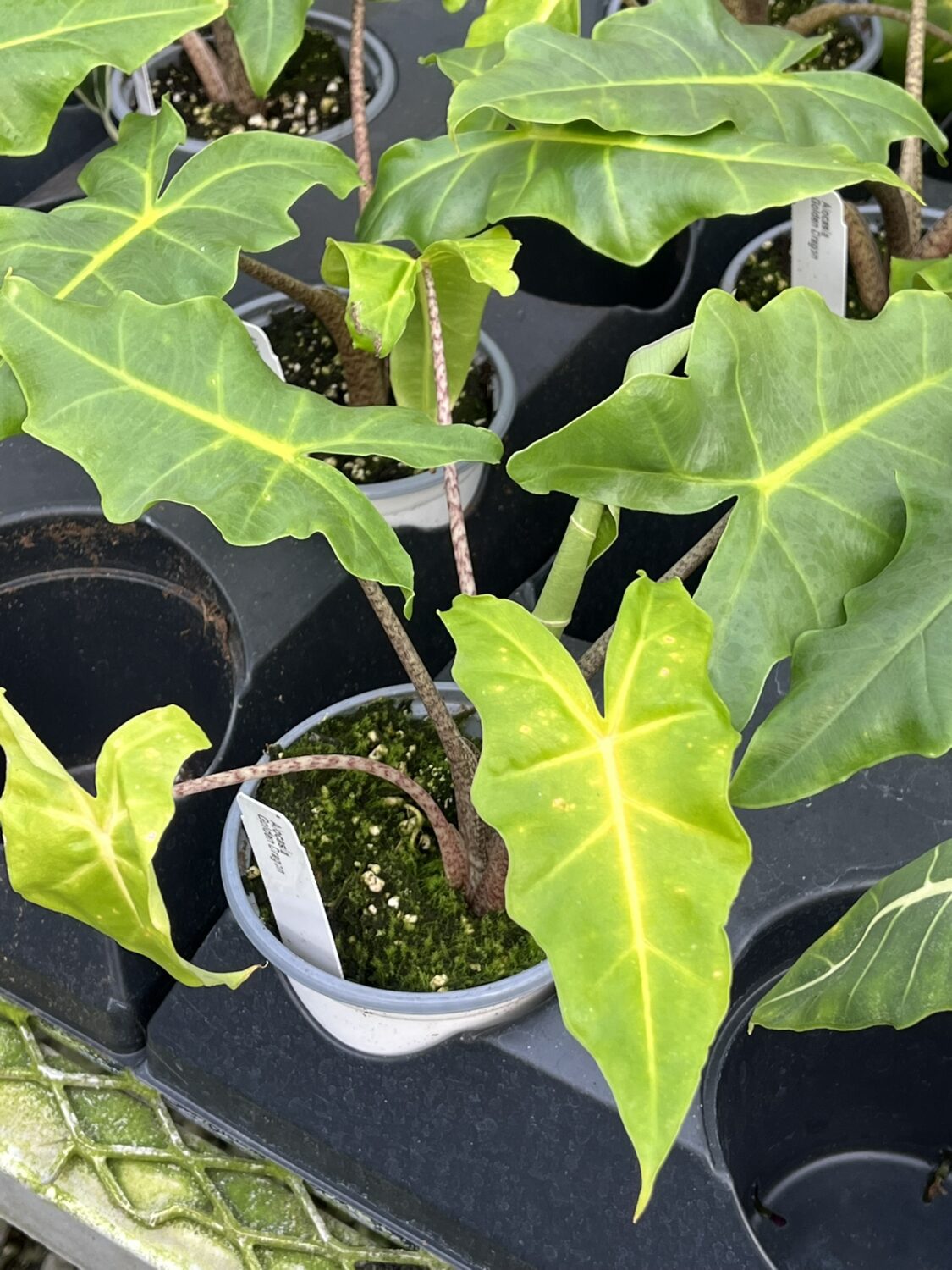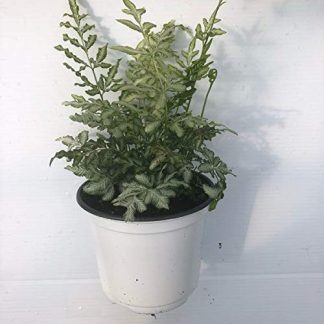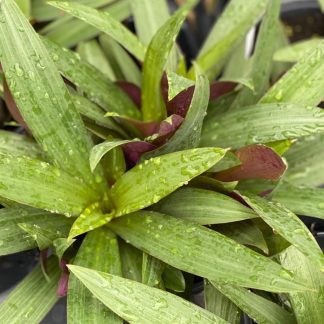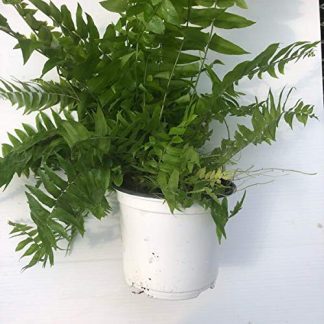Description
Alocasia ‘Golden Dragon’: A Guide to Growing This Exotic Beauty
Alocasia ‘Golden Dragon’ is one of those plants that feels almost mythical. With bold, sculptural leaves patterned in vibrant greens and golds, it earns its name by resembling a dragon’s shimmering scales. This rare member of the Alocasia family is both dramatic and elegant, adding instant tropical energy to any home or garden.
Native to the rainforests of Southeast Asia, the Golden Dragon thrives in warmth and humidity. It’s prized for its large, elongated foliage with deep veining and striking color contrasts. Whether showcased as a centerpiece or tucked into a jungle-inspired collection, this plant turns heads.
Beyond its looks, Alocasia ‘Golden Dragon’ helps purify indoor air, making it both beautiful and functional. The best part? With the right care, it’s manageable for beginners and rewarding for seasoned plant lovers alike.
Getting Started with Alocasia ‘Golden Dragon’
Growing this plant is straightforward when you mimic its natural tropical habitat. Let’s break down everything you need to know—step by step.
Propagation and Planting
The easiest way to propagate Alocasia ‘Golden Dragon’ is by division. This method uses the plant’s natural offsets, or “pups,” that sprout at the base.
How to Propagate by Division:
-
Gently remove the plant from its pot and inspect the roots.
-
Separate the offsets, making sure each has roots and a stem.
-
If needed, cut carefully with a clean, sharp knife.
-
Pot each offset in fresh, well-draining soil.
-
Water lightly and place in warm, bright, indirect light.
Spring and summer are the best seasons for propagation, when the plant is actively growing.
Light Requirements
Golden Dragon loves bright, indirect light. This lighting keeps its colors vibrant and supports steady growth.
-
Indoors: Place near an east- or north-facing window. Use sheer curtains for south-facing windows to soften direct sun.
-
Outdoors: Grow in partial shade. Avoid full sun, which can scorch its leaves.
Lower light slows growth and dulls leaf patterns, so aim for bright filtered light whenever possible.
Best Soil Mix
The right soil is both rich and airy. You want moisture retention without waterlogging.
Ideal Soil Blend:
-
2 parts potting mix
-
1 part perlite or coarse sand
-
1 part peat moss or coconut coir
-
Optional: orchid bark or charcoal for extra drainage
This combination mimics its rainforest floor conditions—nutrient-rich, moist, and well-draining.
Watering Needs
Golden Dragon prefers soil that is consistently moist but never soggy. It’s sensitive to both drought and overwatering.
Watering Tips:
-
Check the top inch of soil—water when it feels dry.
-
Keep soil moist during spring and summer (active growth).
-
Reduce watering in fall and winter when growth slows.
-
Always use pots with drainage holes to prevent root rot.
Yellowing leaves can signal overwatering, while drooping or curling leaves may indicate the opposite.
Temperature and Humidity
As a tropical plant, Alocasia ‘Golden Dragon’ thrives in warmth and high humidity.
-
Temperature: 65–85°F (18–29°C). Avoid dips below 55°F (13°C).
-
Humidity: 60% or higher is ideal. Use a humidifier, mist leaves, or set the pot on a pebble tray with water.
Protect the plant from cold drafts or sudden temperature changes, which can stress the foliage.
Feeding for Lush Growth
Fertilize during the growing season to support bold, healthy leaves.
-
Use a balanced, water-soluble fertilizer diluted to half strength.
-
Apply every 4–6 weeks in spring and summer.
-
Stop fertilizing in fall and winter when the plant rests.
Flush the soil occasionally with plain water to prevent salt buildup.
Pruning and General Maintenance
Pruning keeps your Golden Dragon neat and healthy.
-
Remove yellow, damaged, or old leaves with clean scissors.
-
Clip spent flower stalks so energy returns to foliage.
-
Wipe leaves with a damp cloth to remove dust and boost shine.
-
Rotate the plant every few weeks for even growth.
Managing Pests and Disease
Alocasia ‘Golden Dragon’ is tough but can attract common houseplant pests like spider mites, mealybugs, and aphids.
Prevent and Treat Pests:
-
Inspect leaves regularly, especially undersides.
-
Wipe pests away with a damp cloth or spray with mild soapy water.
-
Use neem oil or insecticidal soap for persistent infestations.
Prevent Disease:
-
Avoid overwatering to reduce root rot risk.
-
Ensure good air circulation to prevent fungal issues.
Repotting for Healthy Growth
Repot every 1–2 years or when roots start circling the pot.
How to Repot:
-
Remove the plant gently and shake off old soil.
-
Inspect roots and trim any rot.
-
Choose a pot 1–2 inches wider than the old one.
-
Replant at the same depth with fresh, well-draining soil.
Repotting in spring or early summer gives the plant a head start.
Special Seasonal Care
-
Winter Dormancy: Growth may slow or stop. Reduce watering and skip fertilizer.
-
Outdoor Growing: Bring indoors before temperatures drop below 55°F (13°C).
-
Leaf Cleaning: Regularly clean leaves to maximize photosynthesis and highlight their gold patterns.
Why Alocasia ‘Golden Dragon’ is Worth It
Few plants combine drama, color, and tropical flair quite like Alocasia ‘Golden Dragon.’ Its elongated, patterned leaves make it a showpiece, whether it’s the star of a living room corner or part of a lush indoor jungle. Plus, it’s manageable to care for—no expert skills required, just consistent attention.
By following these simple guidelines—bright indirect light, moist but well-drained soil, warm temperatures, and high humidity—you’ll help your Golden Dragon thrive. Over time, you’ll watch it grow into an even more striking specimen, rewarding your care with every new leaf.
Bringing Tropical Majesty to Your Space
Alocasia ‘Golden Dragon’ isn’t just a plant. It’s living art. It reminds us of the beauty found in tropical rainforests and invites a piece of that magic into our homes. When you give it what it needs—warmth, moisture, and a bit of admiration—it rewards you with leaves that look almost mythical.
Ready to add this showstopper to your collection? Your indoor jungle is about to get a lot more vibrant.




